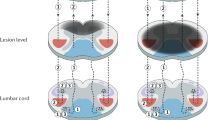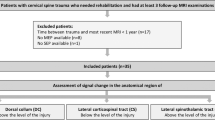Summary
The acute traumatic central cord syndrome (ATCCS) is commonly stated to result from an injury which affects primarily the center of the spinal cord and is frequently hemorrhagic. To test the validity of this widely disseminated hypothesis, the magnetic resonance images [MRI] of 11 consecutive cases of ATCCS caused by closed injury to the spine were analyzed and correlated with the gross pathological and histological features of 3 cervical spinal cords obtained at post mortem from patients with ATCCS, including 2 of patients studied by MRI. The MRI studies were performed acutely (18 h to 2 days after injury) in 7 patients and subacutely (3–10 days after injury) in 4. Ten of the 11 patients had pre-existing spondylosis and/or canal stenosis. The 11th suffered a cervical fracture. All patients exhibited hyperintense signal within the parenchyma of the cervical spinal cord on gradient echo MRI. None showed MRI features characteristic of hemorrhage on T1-weighted spin echo or T2*-weighed gradient echo studies. Gross and histological examination of the necropsy specimens showed no evidence of blood or blood products within the cord parenchyma: the primary finding was diffuse disruption of axons, especially within the lateral columns of the cervical cord in the region occupied by the corticospinal tracts. The central gray matter was intact. In patients with ATCCS, the predominant loss of motor function in thedistal muscles of the upper limbs may reflect the importance of the corticospinal tract for hand and finger function in the primate. In this study, the MRI and pathological observations indicate that ATCCS is predominantly a white matter injury and that intramedullary hemorrhage is not a necessary feature of the syndrome; indeed, it is probably an uncommon event in ATCCS. We suggest that the most common mechanism of injury in ATCCS may be direct compression of the cervical spinal cord by buckling of the ligamenta flava into an already narrowed cervical spinal canal; this would explain the predominance of axonal injury in the white matter of the lateral columns.
Similar content being viewed by others
References
Schneider RC, Cherry GL, Pantek HE (1954) The syndrome of acute central cervical spinal cord injury. J Neurosurg 11:546–577
Rand RW, Crandall P (1962) Central spinal cord syndrome in hyperextension injuries of the cervical cord. J Bone Joint Surg [Br] 44:1415–1422
Schneider RC, Thompson JM, Bebin J (1958) The syndrome of the acute central cervical spinal cord injury. J Neurol Neurosurg Psychiatry 21:216–227
Hopkins A, Rudge P (1973) Hyperpathia in the central cord syndrome. J Neurol Neurosurg Psychiatry 36:637–642
Bohlman HH, Ducker TB, Lucas JP (1982) Spine and spinal cord injury. In: Rothman R, Simeone FA (eds) The spine, 2nd edn., Saunders, Philadelphia, pp 680–681
Miklossy J, Clarke S, Van der Loos H (1991) The long distance effects of brain lesions: visualization of axonal pathways and their termination in the human brain by the Nauta method. J Neuropathol Exp Neurol 50:595–614
Hardman JM (1985) Cerebrospinal trauma. In: Davis RL, Robertson DM (eds) Textbook of neuropathology. Williams & Wilkins, Baltimore, pp 867–886
Chakeres DW, Flickinger F, Bresnahan JC, Beattle MS, Weiss KL, Miller C, Stokes BT (1987) MR imaging of acute spinal cord trauma. AJNR 8:5–10
Hackney DB, Asato R, Joseph PM, Carvlin MJ, McGrath JT, Grossman RI, Kassab EA, DeSimone D (1986) Hemorrhage and edema in acute spinal cord compression: demonstration by MR imaging. Radiology 161:387–390
Schoeman-Claeys E, Frija G, Cuenod CA, Begon D, Paraire F, Martin V (1990) MR imaging of acute spinal cord injury: results of an experimental study in dogs. AJNR 11:959–965
Kadoya S, Nakamura T, Kobayashi S, Yamamoti I (1987) Magnetic resonance imaging of acute spinal cord injury. Neuroradiology 29:252–255
Mirvis SE, Geisler FH, Islinek JJ, Joslyn JN, Gellard F (1988) Acute cervical spine trauma: evaluation with 1.5T MR imaging. Radiology 166:807–816
Kulkarni MV, McCardle CB, Kopanicky D, Miner M, Cotler HB, Lee KF, Harris JH (1987) Acute spinal cord injury: MR imaging at 1.5T. Radiology 164:837–843
Flanders AE, Schaefer DM, Doan HT, Miskin MM, Gonzalez CF, Northrup BE (1990) Acute cervical spine trauma: correlation of MR imaging with degree of neurologic deficit. Radiology 177:25–33
Nathan PW, Smith MC (1956) Long descending tracts in man. I. Review of present knowledge. Brain 78:248–304
Foerster O (1936) Symptomatologie der Erkrankungen des Rückenmarks und seiner Wurzeln. Handb Neurol 5:1–403
Phillips CG, Porter R (1977) Corticospinal neurones. Their role in movement. Monographs of the Physiological Society No 34. Academic Press, London
Eidelberg E (1981) Consequences of spinal cord lesions upon motor function, with special reference to locomotor activity. Prog Neurobiol 17:185–202
Goech HH, Gooding E, Schneider RC (1972) An experimental study of cervical spine and cord injury. J Trauma 12:570–576
Bracken MB, Shepard MJ, Collins WF, Holford TR, Young W, Baskin DS, et al (1990) A randomized, controlled trial of methyl prednisolone or halaxone in the treatment of acute spinal cord injury. N Engl J Med 322:1405–1411
Author information
Authors and Affiliations
Additional information
Supported by grant no. 1 POI NS28059-01A1, “Study of cellular therapy in chronic spinal cord injury,” project 2, R. M. Quencer, M. D., P. I., from the National Institute of Neurological Disorders and Stroke (NINDS), and The Miami Project to Cure Paralysis.
Rights and permissions
About this article
Cite this article
Quencer, R.M., Bunge, R.P., Egnor, M. et al. Acute traumatic central cord syndrome: MRI-pathological correlations. Neuroradiology 34, 85–94 (1992). https://doi.org/10.1007/BF00588148
Received:
Issue Date:
DOI: https://doi.org/10.1007/BF00588148




